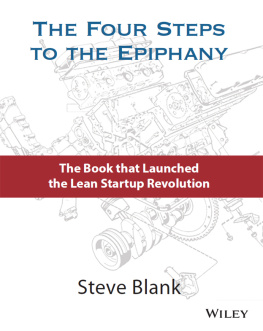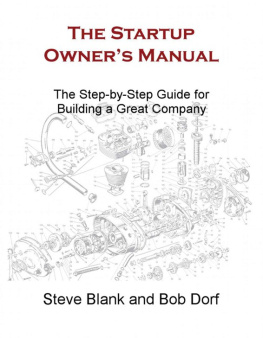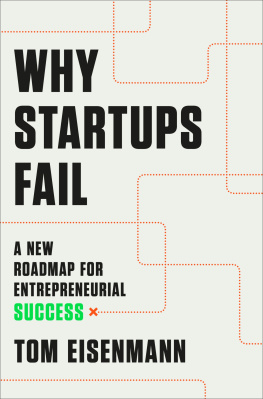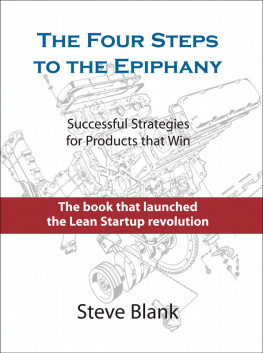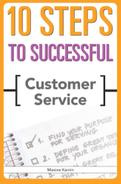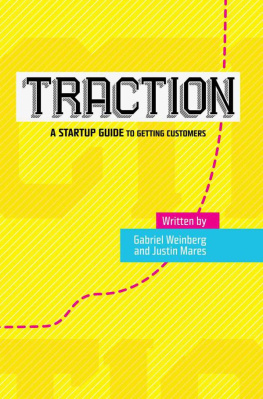
The Four Steps
to the Epiphany
Successful Strategies for
Products that Win
Steve Blank
Fifth Edition
Copyright 2020 by Steve Blank. All rights reserved.
The cover, design, and content are the same as the prior release and should not be considered a new or updated product.
Published by John Wiley & Sons, Inc., Hoboken, New Jersey.
Published simultaneously in Canada.
The Four Steps to the Epiphany, fifth edition was originally published by K&S Ranch Publishing Inc., K&S Ranch Publishing Division in 2013.
No part of this publication may be reproduced, stored in a retrieval system, or transmitted in any form or by any means, electronic, mechanical, photocopying, recording, scanning, or otherwise, except as permitted under Section 107 or 108 of the 1976 United States Copyright Act, without either the prior written permission of the Publisher, or authorization through payment of the appropriate per-copy fee to the Copyright Clearance Center, Inc., 222 Rosewood Drive, Danvers, MA 01923, (978) 750-8400, fax (978) 646-8600, or on the Web at www.copyright.com. Requests to the Publisher for permission should be addressed to the Permissions Department, John Wiley & Sons, Inc., 111 River Street, Hoboken, NJ 07030, (201) 748-6011, fax (201) 748-6008, or online at http://www.wiley.com/go/permissions.
Limit of Liability/Disclaimer of Warranty: While the publisher and author have used their best efforts in preparing this book, they make no representations or warranties with respect to the accuracy or completeness of the contents of this book and specifically disclaim any implied warranties of merchantability or fitness for a particular purpose. No warranty may be created or extended by sales representatives or written sales materials. The advice and strategies contained herein may not be suitable for your situation. You should consult with a professional where appropriate. Neither the publisher nor author shall be liable for any loss of profit or any other commercial damages, including but not limited to special, incidental, consequential, or other damages.
For general information on our other products and services or for technical support, please contact our Customer Care Department within the United States at (800) 762-2974, outside the United States at (317) 572-3993 or fax (317) 572-4002.
Wiley publishes in a variety of print and electronic formats and by print-on-demand. Some material included with standard print versions of this book may not be included in e-books or in print-on-demand.
If this book refers to media such as a CD or DVD that is not included in the version you purchased, you may download this material at http://booksupport.wiley.com. For more information about Wiley products, visit www.wiley.com.
ISBN 971119690351 (Hardcover)
ISBN 971119690283 (ePDF)
ISBN 971119690375 (ePub)
PREFACE
The Hero's Journey
A legendary hero is usually the founder of somethingthe founder of a new age, the founder of a new religion, the founder of a new city, the founder of a new way of life. In order to found something new, one has to leave the old and go on a quest of the seed idea, a germinal idea that will have the potential of bringing forth that new thing.
Joseph Campbell, Hero with a Thousand Faces
Joseph Campbell popularized the notion of an archetypal journey that recurs in the mythologies and religions of cultures around the world. From Moses and the burning bush to Luke Skywalker meeting Obi wan Kenobi, the journey always begins with a hero who hears a calling to a quest. At the outset of the voyage, the path is unclear, and the end is not in sight. Each hero meets a unique set of obstacles, yet Campbell's keen insight was that the outline of these stories was always the same. There were not a thousand different heroes, but one hero with a thousand faces.
The hero's journey is an apt way to think of startups. All new companies and new products begin with an almost mythological visiona hope of what could be, with a goal few others can see. It's this bright and burning vision that differentiates the entrepreneur from big company CEOs and startups from existing businesses. Founding entrepreneurs are out to prove their vision and business are real and not some hallucination; to succeed they must abandon the status quo and strike out on what appears to be a new path, often shrouded in uncertainty. Obstacles, hardships and disaster lie ahead, and their journey to success tests more than financial resources. It tests their stamina, agility, and the limits of courage.
Most entrepreneurs feel their journey is unique. Yet what Campbell perceived about the mythological hero's journey is true of startups as well: However dissimilar the stories may be in detail, their outline is always the same. Most entrepreneurs travel down the startup path without a roadmap and believe no model or template could apply to their new venture. They are wrong. For the path of a startup is well worn, and well understood. The secret is that no one has written it down.
Those of us who are serial entrepreneurs have followed our own hero's journey and taken employees and investors with us. Along the way we've done things our own way, taking good advice, bad advice, and no advice. On about the fifth or sixth startup, at least some of us began to recognize there was an emerging pattern between our successes and failures. Namely, there is a true and repeatable path to success, a path that eliminates or mitigates the most egregious risks and allows the company to grow into a large, successful enterprise. One of us decided to chart this path in the following pages.
Discovering the Path
Customer Development was born during my time spent consulting for the two venture capital firms that between them put $12 million into my last failed startup. (My mother kept asking if they were going to make me pay the money back. When I told her they not only didn't want it back, but were trying to see if they could give me more for my next company, she paused for a long while and then said in a very Russian accent, Only in America are the streets paved with gold.) Both venture firms sought my advice for their portfolio companies. Surprisingly, I enjoyed seeing other startups from an outsider's perspective. To everyone's delight, I could quickly see what needed to be fixed. At about the same time, two newer companies asked me to join their boards. Between the board work and the consulting, I enjoyed my first-ever corporate out-of-body experience.
No longer personally involved, I became a dispassionate observer. From this new vantage point I began to detect something deeper than I had seen before: There seemed to be a pattern in the midst of the chaos. Arguments I had heard at my own startups seem to be repeated at others. The same issues arose time and again: big company managers versus entrepreneurs, founders versus professional managers, engineering versus marketing, marketing versus sales, missed schedule issues, sales missing the plan, running out of money, raising new money. I began to gain an appreciation of how world-class venture capitalists develop pattern recognition for these common types of problems. Oh yes, company X, they're having problem 343. Here are the six likely ways that it will resolve, with these probabilities. No one was actually quite that good, but some VCs had golden guts for these kinds of operating issues.
Next page
